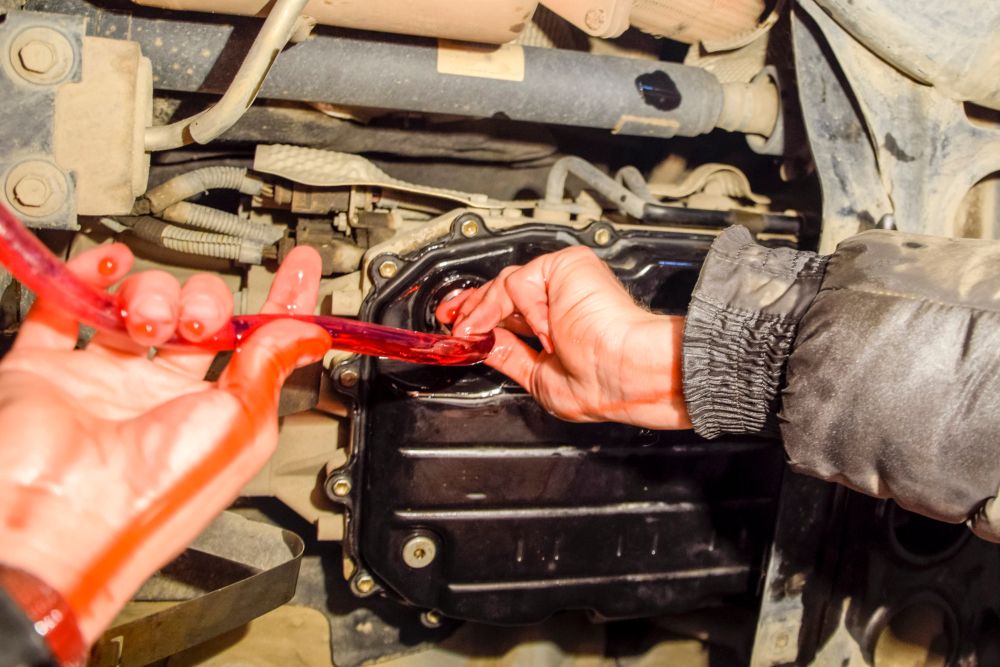
At Dodson Performance Service Centre, we understand that the process of changing automatic transmission oil requires precision, care, and a thorough understanding of your vehicle’s specific needs. This operation, while not as frequently undertaken as an oil change, is crucial for the longevity and optimal performance of your vehicle’s transmission system.
Gathering Necessary Tools
Having the correct tools on hand before you begin the task of changing your automatic transmission oil is crucial.
These essential tools include a collection pan, a socket or spanner, a funnel, a clean bucket, and fundamental safety equipment – jack stands and wheel chocks. In some cases you will need a pump to put the new fluid in, if the filler port is not accessible from above.
The primary function of these tools is to ensure a smooth and damage-free change of the old automatic transmission fluid (ATF). The collection pan and clean bucket are used to collect the old ATF as it drains from the transmission pan, preventing any unwanted leaks or spills.
For the removal of the drain plug or bolts from the transmission pan, we recommend using a socket wrench or spanner. This is going to depend on which plug your specific transmission has.
The funnel is utilised to pour new ATF into the fill port, facilitating a clean and spill-free refill. If the fluid cannot be filled from above, you will need to use a fluid pump.
Locating the Transmission Pan
The first step in this process involves locating the transmission fluid pan, which is situated at the bottom of the transmission. This pan is an essential part of automatic transmissions as it collects the transmission fluid when the vehicle is not in motion.
Typically, the transmission pan is secured directly to the base of the transmission and can be recognised by its rectangular shape and metallic build. In some instances, it may be necessary to remove the bolts fastening the pan to the transmission to facilitate a comprehensive transmission fluid change. This also allows us to inspect the transmission fluid filter and other components.
Before we start, we place a drain pan under the vehicle to catch the fluid that will spill when the transmission pan is detached. This crucial step ensures we maintain a clean working area. Meanwhile, we also check the dipstick located in the engine bay, as it offers valuable information about the fluid’s state.
The removal of the transmission pan and the subsequent transmission fluid change is a complex process that requires precision and care.
Draining Old Transmission Fluid
The next step in this process is to carefully drain the old fluid from the transmission system. This task necessitates precision and vigilance to avoid any unexpected damage to your vehicle’s transmission mechanism.
To start, our expert technicians locate the drain plug on your transmission pan, typically found at the bottom of the pan. It’s imperative to ensure the safe collection of the old transmission fluid, thereby preventing any spillage or environmental contamination. Accordingly, we place an appropriate pan beneath the drain plug to collect the draining fluid.
Upon successful removal of the sump plug, the old transmission fluid begins to drain out.
We allow the old fluid to completely drain, which might take some time. Once drained, we diligently clean your transmission pan before advancing to the next step in the transmission fluid change procedure.
Replacing the Fluid Filter
Once the old fluid has been drained, the next step in the process is the replacement of the fluid filter. When we carry out a transmission fluid change, it’s imperative to also replace the fluid filter to ensure that your new transmission operates at peak efficiency. This is because over time, debris can build up and affect the performance of the transmission.
Refilling With New Fluid
Once the new filter is in place, we replenish the transmission with new fluid. It is crucial to utilise the correct type of transmission fluid for your car and use case. Always refer to your owner’s manual for the manufacturer’s recommendations, or ask us if you need something specific.
Upon determining the fluid you require, commence the refilling process. A funnel is recommended to prevent spillages, and one should gradually add more fluid into the transmission. It’s essential not to overfill; therefore, it’s necessary to closely monitor the fluid level using the dipstick.
Here are some steps to adhere to:
- Preparation:
- Ensure the correct type of transmission fluid is at hand
- Have a funnel ready
- Process:
- Begin by introducing a small quantity of fluid
- Assess the fluid level using the dipstick
- Persist in adding more fluid until the desired level is attained
Once filled, operate the vehicle for a brief distance to circulate the fluid. After driving, verify the fluid level to ensure it remains at the correct level. If necessary, introduce more fluid until it reaches the recommended level. This procedure ensures your vehicle sustains its performance and complies with the manufacturer’s recommendation.
Need Your Transmission Fluid Changed?
If you need your transmission fluid changed, be sure to speak to us by calling 09 441 3635 or emailing service@dodsonmotorsport.com.

 Looking for Dual Clutch transmission components outside of New Zealand?
Looking for Dual Clutch transmission components outside of New Zealand?